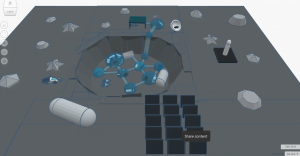Moon Camp Explorers Gallery 2020-2021
In Moon Camp Explorers each team’s mission is to 3D design a complete Moon Camp using Tinkercad. They also have to explain how they will use local resources, protect astronauts from the dangerous of space and describe the living and working facilities.
Team: D.I.A.K.H.A.
Ellinogermaniki Agogi Athens Greece 14
External link for 3d
|
Project description
The name of our moon camp project is D.I.A.K.H.A. and the goal of our project is to familiarize ourselves with the Tinker card program, while at the same time learn about the moon and how E.S.A missions are planned and accomplished. The purpose of the moon camp base we designed, is to provide a safe and practical environment for astronauts who will possibly be part of long term, future missions to the moon. The moon camp base is composed of Titanium. Titanium has the highest strength to weight ratio of any natural metals known to man. It is also very lightweight and possesses low heat conductivity. Therefore, we found its use ideal. The moon camp base can cater for and accommodate maximum 6 astronauts for half a year. The base consists of ten designated areas for different needs and purposes. There are four rooms that cover the astronauts’ basic needs, dormitories, a bathroom, a dining room, and an infirmary. The other six areas cover the astronauts’ secondary needs or assist their work. Specifically, we have created a science lab, a parking space for the rovers, a space for the crew to relax, a room dedicated to all communication systems, a gym equipped with the necessary equipment and a greenhouse for growing crops. |
|||
|
Where do you want to build your Moon Camp?
Shackleton crater Why did you choose this location?
The location chosen for the building of the base is in the Shackleton crater, on the south side of the moon. The main reason behind this choice is that the crater possesses a large amount of lunar water that can be used and recycled for the preservation of our base, or even for consumption purposes after filtering it. Furthermore, the exterior of the crater is exposed to enough sunlight to maintain a decent temperature, while its interior is completely shadowed, providing protection from the sun’s dangerous radiation. How do you plan to build your Moon Camp? Which materials would you use?
Titanium is one of the materials we decided on using. As mentioned earlier on, titanium has been proven useful in various ways. Its strength, weight, and long-term properties makes it quite ideal for use in outer space. Concrete is a mortar, commonly used on earth, made from a combination of mineral aggregates, water, and different binders. Unfortunately, the exact ingredients cannot be found on the moon, but, using moon dust, lunar water and lunar regolith, that is, the fine balsamic gray sand that is similar to volcanic sand on Earth. Concrete can be recreated on the moon, with this cost reducing formula. The main base design is circular, connected to the different rooms through titanium hallway-tubes. The outer portion of the rooms is protected by a titanium layer. And the main skeleton is composed from the moon concrete formula. The base is constructed from ten circular pod like rooms, that are all connected by titanium hallways. Thanks to Titanium’s lightness, the necessary Titanium supply can be brought from earth. During the construction of the base, astronauts will take cover in the rocket ship. Explain how your Moon Camp will provide the astronauts with:
|
|||
|
Water
|
Food
|
Electricity
|
Air
|
|
In order to supply the future astronauts with water we intend to use the Urine Processor Assembly, a system which recycles the astronauts sweat and urine into useful and consumable water, using an ingredient called Alternate Urine Pretreatment Solution. In addition to the U.P.A., due to the choice of location made, we are also able to retrieve Luna water from inside the crater which after proper filtering can be consumed. |
In order to provide the crew with a sufficient amount of food a lunar greenhouse will be built and preserved. We have selected specific crops to grow, like duckweed- small plants that mainly thrive in ponds, and somewhat look like lentils. As well as potatoes and carrots. Additionally, a decent supply of food from earth. |
Light from the sun will be used and converted into electricity via strong solar panels. The solar wind flows over natural obstacles on the moon, such as the lips of craters at the poles, craters can be charged with hundreds of volts, which can be proven useful when power is needed. |
As to producing our own supply of oxygen we will be following E.S.A ‘s method of turning moon dust into oxygen with a mineral extraction process which will allow us to retrieve any needed amount of oxygen. Moreover, we plan to use the lunar water from the crater to produce oxygen and water by using the method of electrolysis. |
|
Describe a day on the Moon for one of your Moon Camp astronauts
Α typical day on campus would resemble to the following description. Naturally there would be a specific time for the astronauts to start their day. Three main tasks will be divided among the 6 astronauts: construction, maintenance, and research. All breaks would be pre – planned, as well as meal hours, curfew, and working hours. For example, members of the crew given maintenance tasks, might have to take up cleaning the living areas, or taking care of the greenhouse. While others might be assigned accumulative tasks, like gathering moon rocks and useful minerals. All astronauts would also have a scheduled period of time each day, to exercise in the gym, to keep their muscles and bones in good shape. Crew members will also have up to two hours dedicated to rest or communication. |
|||







